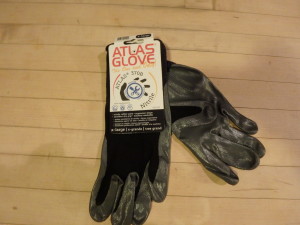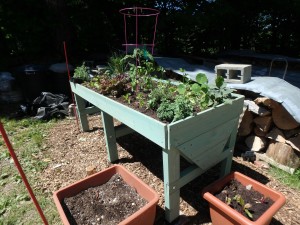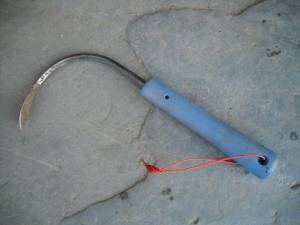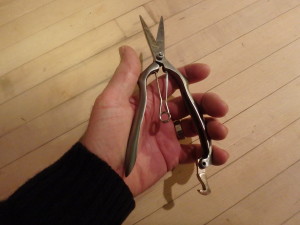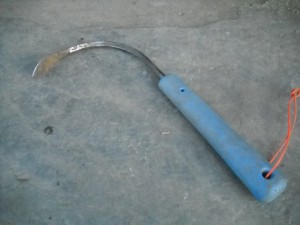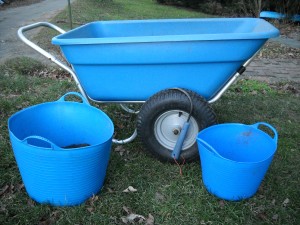Holiday Gifts for the Gardener
It’s that time of the year again: time to figure out good gifts for Uncle Albert and your sister Sadie. If they’re gardeners, gifts are easy to pick. There are plenty of items that cost from $5 to $300, and generally, one size fits all. Let’s look at some things I have used and like.
After giving a talk at the Milford, NH Garden Club recently, I bought some gardening gloves that were being sold as a fund raiser. These cost me just $5, and have already earned their keep. These are nitrile gloves made by the Atlas Glove Company. They have a waterproof palm and a stretchy, breathable fabric back. I have big hands, and the x-large size was perfect. Mine are black with silver palms, but the smaller sizes come in a variety of colors.
I don’t generally wear gloves when gardening, as most are too thick – and I like the feel of the soil – but in cold weather I do wear them. These are thin enough that I can go easily in my pants pocket and pull out my pocket knife, or feel a tender weed. The nitrile glove is the Atlas 370B series. I’ve also used a thicker Atlas glove with a natural rubber palm, the 300 series. These are both available at most gardening centers.
Does your loved one start plants by seed? Gift cards at garden centers or seed companies are nice. I get my seeds from several places: the Hudson Valley Seed Library, Johnny’s Selected Seeds, High Mowing Seeds, Renees Garden and a young company in New York State, Fruition Seeds. All have wonderful selections.
One of my favorite additions to my garden this year was a “VegTrug” from Gardener’s Supply Co. (www.gardeners.com, Item#8586918). This is a stained cedar planting box on legs, about 6 feet long and 32 inches wide that retails for $279, with free shipping. It is V-shaped in cross section with the deepest portion 16 inches deep – deep enough for potatoes or tomatoes. It stands 32 inches tall, so no bending is needed to weed or to pick.
In my VegTrug I grew one patio tomato and pretty much every kind of herb: basil, dill, marjoram, thyme, sage, purple sage, chives, oregano and parsley. I even had a nasturtium cascading over one end.
One reason I loved my VegTrug was the convenience: it allowed me to have herbs near the house in a spot not otherwise suitable for growing. And the plants grew well, although in the heat of the summer they dried out more quickly than my garden near the stream, so I watered pretty much every sunny day. It uses 380 liters of soil mix, so I made my own, a 50-50 mix of peat moss and compost. The bottom is slotted for drainage, but it comes with a woven liner to prevent soil from washing away.
Every gardener needs a good weeding tool, and every year I recommend the CobraHead Weeder, because I believe it is the best weeding tool available. This tool has a single tine that is curved like the shape of a rising Cobra. I use it to tease out grass roots, to get under large weeds (so I can loosen the soil below them and pull from both top and bottom of the weed at the same time), and for preparing soil to plant. Now it seems a part of my right hand (though it is right-left neutral). At under $25 locally or from the manufacturer (a family business found at www.CobraHead.com), this tool is tough, strong, and made in the USA.
Every year I try to learn more about growing healthy plants. This year I paid $50 to join the Bionutrient Food Association (http://bionutrient.org/), and would like to suggest giving a membership as a nice present. One of the goals of the non-profit is to educate members about how to grow food that is nutrient-rich.
Much commercial agriculture depends on adding just 3 minerals to the soil (nitrogen, phosphorus and potassium) and basically ignoring the other nutrients that plants – and humans – need to be healthy. Growing vegetables year after year removes micronutrients from the soil that need to be replaced. The BFA offers information and workshops that I believe will help me to grow better food and stay healthy.
Weeds are the bane of many gardeners. One way to minimize their presence is to weed daily, mulch, or to put down weed mats. A Vermont company, Garden Mats (https://gardenmats.com) produces heavy-duty woven mats with pre-cut holes in a variety of patterns for different vegetables. I’ve used them – and re-used them. They keep down weeds, hold in some moisture, but also breathe and let rain penetrate. They are 4 feet wide and come in lengths of 6, 12 and 18-feet for a cost of $11 to $31. They are definitely a labor-saver, and they claim the mats increase yields 10% to 20%, too. I like them, and also the fact that it is a small, family-owned business.
The last item for this year’s list is a lovely pair of stainless-steel garden shears for cutting flowers, herbs, and for use in the kitchen. Made in England, these shears are elegant as well as sturdy, and are said to be designed for small hands. Sold by Gardeners Supply (Item#8593404), they retail for $60 and come in a handsome gift box.
Santa, if you’re listening, I have everything I need. So you can just volunteer to come work in my garden next summer. I know it’s the off-season for you, and we both need to lose some weight, anyhow. We can pull weeds and eat cukes.
Read Henry’s blog at https://dailyuv.com/gardeningg
Holiday Gifts for the Gardener
When I was a boy we made lots of our own Christmas gifts. I remember making a wooden whale for my dad that held pencils – it had little holes just the diameter of pencils I drilled into it. I must have been 8 or 9 when I made it, and I have no idea how I was able to do it without his help. Maybe it was a Cub Scout project. Not elegant, but there was lots of love in it.
As gardeners, we can make presents, too – if we have extra produce that we have put up. Dried tomatoes, pickles, even a frozen bag of blueberries or elderberries would be much appreciated, I’m sure – though putting frozen berries under the tree might not work well. And then there are heirloom seeds. I grow certain tomatoes and peppers that are not commercially available. I save seeds each year, and share with friends. These are all good presents that cost nothing.
Although seed catalogs used to come in the mail in mid-winter, now most seeds are available on-line before Christmas. A few packages of seeds are nice low-budget gift. I get many of my seeds from Johnny’s Select Seeds in Maine (www.johnnyseeds.com), High Mowing Seeds of Vermont (www.highmowingseeds.com) or Hudson Valley Seed Library (www.seedlibrary.org), which is a non-profit with nice heirloom seeds.
From Johnny’s this year I got two kinds of tomato seeds that are fairly resistant to late blight. First there was the Defiant F-1which produced well early on, but then died off when other fungal diseases took over. Then there was Mountain Magic, a small salad-type tomato that was very disease resistant and productive for me. All of the High Mowing seeds are organic, which I like.
Also in the cheap (or shall we say the ‘frugal’) category is a gift certificate for an hour or two of weeding. That’s a gift anyone would really appreciate. And feel free to send me one! Weeding is a pleasant enough task, but is always more fun if done with a friend.
Before going on to more conventional gardening presents, let me point out that most things I will mention are available locally at your garden center, feed-and-grain or hardware store. I firmly believe that it is better to buy locally than on line, as that keeps our family-owned businesses healthy. And they are the ones that support our teams, schools and charities.
Gardening gloves are always useful. The Atlas Glove company now makes a thin, tough nitrile gardening glove that is sold for under $10. Stretchy nylon coated with waterproof nitrile. Buy them locally, or from Gardener’s Supply Company (www.gardeners.com) in a variety of pretty colors.
Also from Gardener’s Supply is a nice expandable bamboo trellis. A friend gave me one, and I used it for growing my peas. Instead of letting it touch the soil, I tied it onto posts so the bottom was 6 inches off the ground, to minimize rot. Cost? $20-$25, depending on size.
On the high end of the spectrum would be a new wheelbarrow. The best I have found is the Muller’s Smart Cart (www. mullerscarts.com). It is a 7 (or 12) cubic foot polyethylene bin that pops in (or out) of an aluminum frame. I have the 7-ft model and have used it hard to over 10 years, yet have never had a flat tire or any other problem with it. The fact that the barrow part is removable allows me to use it to wash the dog in it or carry manure in the back of my sedan. They cost $350, with free shipping. I chose the wide tires, not the bike tires, and find them great, even in soggy conditions. This is a very high quality wheelbarrow that is rated to carry up to 600 lbs.
Every year I recommend my favorite weeding tool, the CobraHead weeder (www.CobraHead.com). This tool is great for getting under weeds, teasing out roots, stirring compost or fertilizer into planting holes, planting bulbs and more. You should be able to find it locally. Cost? About $25.
A gardening magazine subscription would be nice, too. I get Fine Gardening magazine (www.finegardening.com). The magazine has a nice balance of growing information and design ideas. Excellent color photography. $29.95.
I’ve fallen in love with TubTrugs. These are brightly colored flexible buckets I use for carrying weeds, compost and even water. From 3 Gallons to 10 gallons, their flexible handles make them easy to carry. Found locally or from Gardeners Supply in a variety of sizes and colors, around $10.
Gardening books are good gifts, but look for quality info, not necessarily glossy pictures. My website, www.Gardening-guy.com, lists about 25 good ones. Just click on the “Gardener’s Basic Library” on the top bar.
So enjoy the holidays, but remember that Santa’s elves make lots of presents. Get creative and be an elf your self!
Henry Homeyer’s new book is for children ages 8 and up. It’s called Wobar and the Quest for the Magic Calumet, and is a fantasy-adventure about a boy with a mustache – and a cougar who is his best friend. Go to www.henryhomeyer.com to learn more.



